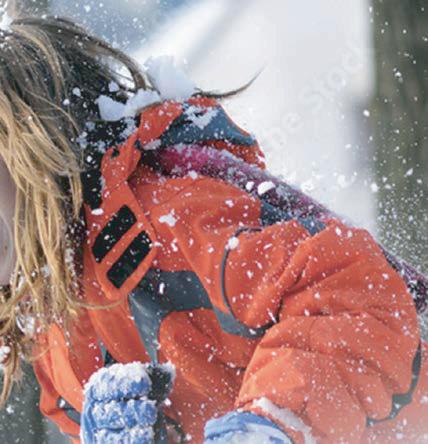
3 minute read
SOUTH PLATTE
the canal could be owing by 2033.
At the 500 cubic feet per second rate the canal has a compact-codi ed right to draw from the Colorado side of the South Platte, the project would deliver about 78,400 acre-feet to Nebraska in an average year for irrigation and storage, the study says. By comparison, Denver Water’s Dillon Reservoir in Summit County can hold 257,000 acre-feet of water. (An acrefoot provides a foot of irrigation water to one acre for a season or supplies two to four typical city households for a year.)
If expected Colorado river development projects take away 50% of the current remaining supply in the South Platte, the study adds, the canal could still deliver 69,900 acrefeet to Nebraska each year. e water could support 1.6 million irrigated acres in Nebraska and bolster municipal supply to faster-growing eastern cities such as Omaha and Lincoln.
Total economic bene ts from the project would range from $698 million to $754 million, an enticing payo for the $567 million project cost, the study adds.
Part of the study’s optimism about how much Colorado water it can get stem from a disagreement over the extent of climate change. Colorado forecasters and engineers predict continuing heavy impacts on the South Platte Basin from an ongoing drought and temperature and snowpack pressures. Nebraska studies “ nd more moderate temperature changes and even stabilized precipitation patterns” for the lower section of the river, the Nebraska report said. e Colorado response letter on future water supply does not include an extensive environmental analysis of the canal’s impacts. But previous studies have warned canal engineers may never overcome the South Platte ow requirements of the Endangered Species Act. e Nebraska report says the canal may actually improve conditions satisfying a 2006 interstate pact to support South Platte wetlands wildlife, but doesn’t explain how
Nebraska’s Deputy Director of Natural Resources Jesse Bradley said the Colorado state engineer’s letter fails to account for the fact that the Nebraska supply study “used a conservative approach.” Bradley’s email attached a photo from near Julesburg showing strong river ow on March 14.
“Even assuming that ows entering the lower section are zero, there will still be signi cant ows available for the canal,” Bradley wrote. Bradley said his photo showed South Platte River ow at the state line near Julesburg was 260 cubic feet per second on a day Nebraska would have the right to divert, even though ows were near zero at the gauge dividing the river’s upper section from the lower section.
“In addition, this does not account for the many junior Colorado recharge projects in the lower section that are currently diverting, but would be curtailed to meet Nebraska’s demand,” he added.

“We have not had the opportunity to discuss the letter with Kevin (Rein) and hope to do so in the future,” Bradley said.

1-877-328-1512 taking more water out before the Nebraska border would achieve that end.





Nebraska o cials have said in some conversations they feel a canal could be completed within four years, said Joel Schneekloth, a regional water resource specialist at Colorado State University. But the likely litigation over EPA environmental impact rules alone could drag on for years, Schneekloth added.
Nonpro ts and water agencies along both the North and South extensions of the Platte River, and the mainstem after they meet 90 miles east of Julesburg, have fought for decades over providing enough water and habitat for whooping cranes.
Northern Water in Colorado started planning the two-reservoir Northern Integrated Supply Project in the early 2000s, and only in late 2022 received its nal federal permit, Schneekloth said. at project faces still more opposition lawsuits.
South Platte River environmental issues will “come into play, and that’s going to be an issue that will be adjudicated,” he said.
In prepared remarks at a January water congress, Colorado Attorney General Phil Weiser listed many reasons why the Nebraska canal is “Stated simply . . . both unwise and unlikely.”
Schneekloth, as well as water experts on the Nebraska side of the border, agree with the Colorado engineer’s pointed questions about where exactly Nebraska can nd the water to ll the canal.
With low o -season ow and all the senior water rights diversions allowed above the Nebraska canal spot, Schneekloth said, “we’re starting out with basically a dry river at that point.” is story is from e Colorado Sun, a journalist-owned news outlet based in Denver and covering the state. For more, and to support e Colorado Sun, visit coloradosun.com. e Colorado Sun is a partner in the Colorado News Conservancy, owner of Colorado Community Media.
While the Nebraska legislature moves forward, they’re hearing from local academics who are similarly skeptical.
“ ere are a lot of senior users in the basin who would basically be able to take the water, so I’m not even sure legally if this canal would really be able to appropriate water out of the South Platte,” an appropriations committee heard in 2022 from Anthony Schutz, a University of Nebraska associate law professor, according to Nebraska public radio.
Nebraska o cials said in their response email to e Colorado Sun that they have “discussed alternatives” to the canal with Colorado that would allow their state to divert South Platte water in a di erent location that would reduce any impact to Colorado landowners.
“ at alternative was dismissed by Colorado, as they indicated they would not recognize Nebraska Compact rights unless the diversion is located” southwest of Julesburg and the tiny hamlet of Ovid.
As for Nebraska shrinking from the implications of the Colorado engineer’s hydrology-questioning letter, Schneekloth is not expecting surrender.
“ ey’re dead serious about this,” he said.










